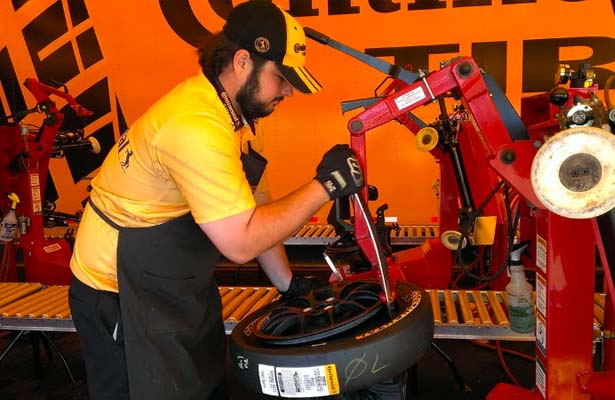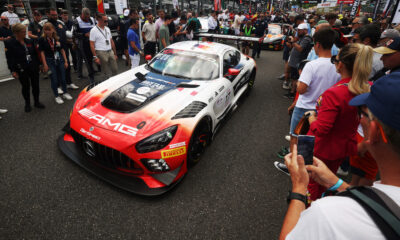
Ten weeks. That’s all the time Continental Tire engineers had to create tires for the DeltaWing coupe – including the unique four-inch tires that are a hallmark feature of the revolutionary sports car prototype.
IMSA officials announced on July 31, 2013 that Continental would be the exclusive tire supplier to the new Prototype class and on Monday, October 21, the new tires were ready to go, as the DeltaWing team received four different tire combinations at a test session the day after the Road Atlanta event.
A remarkable achievement, considering that the South Carolina-based manufacturer would not only be supplying tires to the DeltaWing team, but to the entire Prototype class field – the DeltaWing coupe, the Daytona Prototypes (which were already running on Continentals) and the remaining American Le Mans Series P2 sports cars planning to join the inaugural TUDOR United SportsCar Championship season in 2014.
Charlie Gray is the product development engineer for Continental Tire and the lead engineer in the development of the DeltaWing’s tires. From creation to testing, Gray managed the development process in a time frame that undoubtedly caused more than one sleepless night.
“We were pretty sure we were going to get it,” said Gray, “but we didn’t find out for sure until the end of July. We had assumed we would carry on with the Daytona Prototype teams and we were preparing as much as we could for the other prototypes. We started doing that earlier in the summer, looking at the P2 car and how it would react to different compounds. We didn’t get too deep into it, we were just laying the groundwork. When it became official, we had a lot of work to do in a very short amount of time.”
First Conversations
“I went to the ALMS race at Road America and introduced myself to (then DeltaWing team manager) Dave Price. We had a quick, informal conversation; we talked about some of the characteristics of the two brands the team had run before, their characteristics, trials and tribulations – all the little things that could help us along our way.
“We also measured the tires, to get the physical dimensions correct. After that, we had email conversations with Dave, Alan (Mugglestone, race engineer) and Simon (Marshall, who designed the coupe), talking about what the car wanted and what it needed.
“But from an engineering standpoint, we’d never dealt with a car that had only 27 percent weight distribution on the front with such small tires. So from a dynamics point of view, that’s very different. It was something we struggled with, since we didn’t know what to expect.
“We put a lot of emphasis on the front tire, since it’s so small, but from our very early conversations with Dave, he explained what the drivers needed to feel in the way of aligning torque – as you turn the tire, it wants to correct, so it takes force to turn the tire. The tires have a self-aligning torque that has a peak and then falls off.
“The self-aligning torque pretty much lines up with the lateral force peak, so as you turn the tire, you feel the steering wheel get light, so the drivers know they’re at the peak of lateral force. But you need vertical load to be able to feel that; and obviously, with a very light front load, the drivers sometimes have to just turn and hope for the best.
“When that happens, you’re past the peak of lateral grip and you’re just sliding across the road, which really accelerates the wear. So we were really conscious of making the self-aligning torque very sensitive so the drivers could feel it.
“We knew the basics; dynamic loads, static loads and generally how the car performed, so we started working on the molds. We were able to use an existing 15-inch mold for the DeltaWing’s rear tire, with only small modifications. But the mold for the front tire was all new. The design work on something like that usually takes two months and we did it in six weeks. We did a few iterations – it took a while to get the balance right.”
A New Tire – or Not
Much more goes into creating a new tire than you’d think; even the rear tires, which were much closer in spec to a DP tire than the much smaller front tire, required a few iterations. It’s not about simply modifying an existing mold. A sophisticated racing tire requires perfect balance and performance, which means the first iteration is almost never the final product. But when on such a tight deadline, there is very little room for error.
“It is extremely difficult to create a new tire like this. We blended several tire types with the DP tire design to create the DeltaWing’s four-inch front tire – component placements and build specs were taken from a tire of a similar size while the physical properties of the components were taken from the DP tire. There was also quite a bit of tweaking and tuning on the build spec to make the rear tire come out the way we wanted it to. It’s all a process.”
Testing
Fans will remember that the DeltaWing team returned to Road Atlanta the Monday after the 2013 Petit Le Mans for a private test session. That test was coordinated with Continental as the first step toward finding how close the tire engineers had come on the first try. The DeltaWing team was impressed with the number of different tire compounds Continental brought to the test – and their performance.
“We hit it pretty good, I’d say. The car was quite quick. But even so, we saw some things we could immediately improve on. For example, our front mold profile wasn’t quite right. The tread wear pattern wasn’t as good as we would have liked, so we went back and recut the mold to help the wear profile.
“We had four constructions and three compounds at the test. We learned quite a bit – our baseline was modifying the DP tire, but we did a few iterations, based on spring rates and performance characteristics. We had quite a variety.”
After the Road Atlanta test, Gray and the engineering team had barely four weeks to make the necessary changes before the first test sessions for the new TUDOR United SportsCar Championship, at the site of the first two races of the new series – Sebring International Raceway and the Daytona International Speedway.
“We recut the front mold to get our wear pattern better and brought three different combinations to the Sebring test in November. We had two constructions and two compounds, which gave us three sets total. We found what the car liked, but even so, we went back and recut the front mold again, because it wasn’t quite right.
“We were definitely under the gun. The first test was in October, then we had the two tests in November and straight to the Roar Before the 24 and the race itself. The first tires didn’t even have branding on them – we had to settle on the mold spec, then send it out to get it engraved. In order to make the production deadline for the Rolex 24, we had to hit it pretty good in October and start production right after the November tests.”
The Entire Prototype Class
Continental did encounter a setback, at the Daytona November test. Several Daytona Prototypes lost control following right rear tire failures, prompting IMSA to suspend testing – for all prototypes except the much lighter DeltaWing coupe, which had no tire difficulties.
Continental worked overtime to produce a reinforced tire construction capable of handling the downforce created by the DP’s new aero package on the oval’s high banks. As Gray notes, creating tires for such a divergent group of cars brings its own set of challenges.
“Each of the four prototypes – the P2s, the DPs, the DeltaWing and the Prototype Challenge class – wants very different things from their tires, so that’s a balance. To make a tire that performs at Sebring, VIR and Watkins Glen, and can go from a Daytona Prototype to an LMP2 car that is 400 pounds lighter, is pretty tough. For the majority of the prototype class, we have two different tires – we have a Daytona-style tire and road course-style tire.
“At Daytona, the loading dictates what you can do, so that’s a very durable tire that can handle the loading and the high sustained speeds. In order to do that, you compromise a little on performance. At traditional road courses and street courses, we go back to emphasizing performance a bit more, without giving up any safety aspect. But we have more margins to play with at the flat tracks.
“We used the Daytona-type tire for the PC class at Kansas and we’ll also use it at Watkins Glen – even though Watkins Glen is a traditional road course, it does have some high loading. That’s not to say we’ll always run that tire there, but we’re being extra cautious this year.
“The DeltaWing, however, uses the same tire at every track. The early testing we did looked at the two different types of tires, but the DeltaWing is in a sort of hybrid situation, where it’s not 100% Daytona style or 100% road course style. The DeltaWing’s tire is sort of in the middle, where we have the performance and the integrity that we need. Because it’s so light, we’re not compromising one for the other.”
At the End of the Day
Continental has created a set of tires that not only works for the entire Prototype class, but keeps the ever-escalating costs of racing at a reasonable level, all things considered.
“We made compromises in order to create a tire that could run in 48-degree temperatures at Daytona and in 100 degree heat at Virginia. It helps that we’re a spec tire class – if we were racing another tire manufacturer, we wouldn’t be able to do that. But if we didn’t, the cost would escalate dramatically.”























